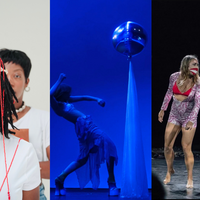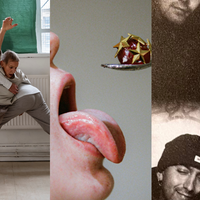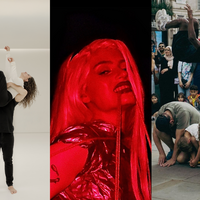Wed 12 Feb: Francesca Matthys, Harry Theadora Foster and Marie-Astrid Mence

News Story
Francesca Matthys Aandag! (Attention.)
Harry Theadora Foster Adam
Marie-Astrid Mence Eves
Who wouldn’t want to rediscover something of the childhood make-believe ability to combine fearless imagination and unselfconscious movement, and do anything? Learn to fly, walk a tightrope, rampage as a finger-horned bull, fence in a duel, blast a leg-barrelled gun. In Harry Theadora Foster’sAdam, snippets of a loving, motherly, home video-recorded voice resurface, and these playful movements are rediscovered with genuine glee–impressively free of mockery or spoof. Reconnection to past innocence occasionally falters, and Foster crawls, desperately dragging his limbs as if after a bender or overdose–adulthood interrupting childhood delights. The first of three in the round performances, it’s the most polished (and the only solo). On stage, several poles extend upwards, each a touch-activated memory cortex. Adam excels in the round: immersion inside someone’s mind and memories. It’s an intimate exploration of childhood memories and mother-son relationships–absorbing, playful and tender.
Marie-Astrid Mence’sEves only finds its feet midway through. Announced by a synthesised, computer game voiceover–“Meet your competitor: Eve”–one of the silver-costumed dancers bursts in to fight the two others in a blitz of strobe-lit, WWE-esque combat that beats even John Wick. Suddenly, it stops–a Roman frieze’s vicious mythical battle. Before this, Eves feels disjointed, a sometimes enjoyable but frequently directionless sci-fi dance, two performers dancing disconnectedly while one watches. The mixture of aggressive and sensual, the glitching, twitching and morphing, reaches for ideas about dehumanising, corrupting technology without quite grasping them. After this, the dance becomes more cohesive, the intensity leads somewhere–an engaging, futuristic techno-cult ritual, cut frustratingly short.
The final performance, Aandag! (Attention.), is the standout piece. Four dancers speak, sing and move to interweave vignettes about family ancestry (“My grandmother is the keeper of our ancestors”) in various languages–Brazilian Portuguese, Afrikaans, English. Francesca Matthys’ piece may not have Adam’s polish–it’s rougher around the edges, with occasional odd transitions–but the highs are glorious. In one episode, they dance inside a knotted string circle, spinning, switching places–nodes in a taut ancestral cycle–until it breaks. They soberly retie and repeat. Georgia Thompson impresses with a whirlwind solo that builds (with repeated shrieks–“In my grandmother’s hands!”–and pounding live drums) into spine-tingling rage. Mixing the earthy stamping and drumming of age-old rituals with the joyous, more light-footed flow of modern Afro-Latin dance, this superb examination of ancestry is both timeless and timely.
Eddy Gibb
Adam by Harry Theadora Foster is a brave work that should be recognised for its authenticity. Looking at memory and identity, Foster uses a combination of child's play, gesture and swirling dervish style dance to communicate his personal, and original movement language. The theatre was set up in the round, and Foster went further by encircling himself with eight metallic poles. They acted as a time travel portal via touch, allowing Foster to enter and leave different episodes during the work and its larger narrative. Throughout we heard the sound of an adult, female voice, very much acting as if Foster’s mother; encouraging, guiding, chastising if necessary. The value of the work is undisputed, but its content and structuring need ongoing development.
Eves by Marie-Astrid Mence discusses the very topical AI subject, in relation to women, competitiveness and dating apps. One wouldn't necessarily get all of the aforementioned through watching the piece, but the AI/tech aspect is definitely on display. Through a combination of metallic attire, gentle strobe lighting and glitchy movement language, one can definitely consider where things might be going - and it doesn't feel positive! Mence uses a street/contemporary dance hybrid, which comes into its strength in the last few minutes of the piece, when the cast of three dance in unison with a grounded feel. Elsewhere the work feels a little too disconnected in nature, and though the execution was more than admirable, some of the content felt unnecessarily sexualised and posey.
Aandag! (Attention.) by Francesca Matthys is an unpredictable work looking at lineage and diaspora in relation to African, Caribbean, and Latin communities in the UK. The overall piece is ritualistic in style from the centrally focused patterning, banging of the floor, touching of the body in meditative state and uncertain structuring. The cast of four all have solo moments, but with varying degrees of prominence, which encourages a sense of imbalance in the work. Voice is used to share personal experiences in relation to lineage, and the live music is so seamless in both performance and connection to the movement one almost forgets that Michael Mendones is actually in the corner doing the do. Of the cast, Georgia Thompson is a dancer impossible not to watch, and Nomakhwezi Becker has the carriage and command of a burgeoning actress.
Matthew Paluch


